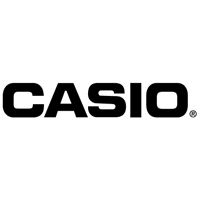Sampled Instruments
Synthesizers, Keyboards & Modules
Akai AX-73 SynthCasio CZ-101
Casio VZ-1
EDP Wasp Synth
Ensoniq SQ-1 Plus
Korg MS 10
Korg MS 20
Korg Poly-800
Novation Super Bass Station
Roland JP-8080/JP-8000
Roland Juno 1
Roland Juno 106
Roland JX-3P
Yamaha TX802
Budget Samples
Access Virus CCasio HT-6000
Cheetah MS6
Clavia Nord Lead 2X
KAWAI K1/K1m/K1r
Korg DW8000
Korg Triton
Novation Supernova II
Quasimidi Technox
Roland D 50
Roland JD800
SCI MAX / 6-Track
SIEL DK 80
Casio
 Today Casio are most well known for their home keyboards but in the 1980s they were known for their inexpensive (at the time) calculators and watches. Even though Casio had a history of innovation, Casio were the first to use the, now common, 10 digit number pad in their calculators and the first to use just one display window. They were also the first to produce quartz crystal watches and they produced the first watch which could show various timezones. The company produced a number of multi-function devices such as watches which featured facilities to measure atmospheric pressure and altitude. Some of their products appeared more like toys or gimmicks, none more so than their amazing VL-1.
Today Casio are most well known for their home keyboards but in the 1980s they were known for their inexpensive (at the time) calculators and watches. Even though Casio had a history of innovation, Casio were the first to use the, now common, 10 digit number pad in their calculators and the first to use just one display window. They were also the first to produce quartz crystal watches and they produced the first watch which could show various timezones. The company produced a number of multi-function devices such as watches which featured facilities to measure atmospheric pressure and altitude. Some of their products appeared more like toys or gimmicks, none more so than their amazing VL-1.
The Casio VL-1 (also known as the VL-Tone) was a curious device which combined a calculator with a synthesiser (or was it the other way around?). The synthesizer, though extremely basic, featured a sequencer and drum beats. The VL-1 was quickly followed by the smaller, and more affordable, VL-10. Although it was generally seen as a toy it sold well and even featured in a number of professional recordings by famous artists. A German band (Trio) even had a hit single(Da Da Da) which consisted of sounds from the VL-Tone and, partly due to this song, the tones of the Casio VL-Tone became instantly recogniseable.
The VL-Tone had 3 drum sounds and 5 preset monophonic tones (Piano, Fantasy, Violin, Flute and Guitar) together with one preset (ADSR) which could be edited but it was all very lo-fi. In 1980 Casio also produced their first Casiotone home keyboard but in 1985 they produced their very first professional synthesizer, the Casio CZ-101. The CZ-101 featured mini-keys which, unfortunately, made it look rather like a toy however it produced sounds using Phase Distortion (PD) synthesis, a form of digital sound synthesis unique to Casio. The sound engine, although digital, sounded much closer to the established analogue synthesis than Yamaha's form which was used in their famous DX7 synthesiser. More professional looking was the Casio CZ-1000 which featured the same sound engine of the CZ-101 but with full sized keys. In 1987 Casio released the FZ-1 which was a sampler which could also function as a synthesiser using harmonic additive synthesis and waveform drawing. A year later (1988) they replaced the CZ range with the VZ-1 which used an updated form of synthesis which Casio called iPD (Phase Distortion Synthesis plus Frequency Modulation Synthesis to create harmonics). During the same period Casio also released keyboards, such as the HT3000, which used another form of synthesis which Casio called Spectrum Dynamic Synthesis or SD for short. Interestingly these synthesizers featured true analogue filters (as well as a few other similarities with standard subtractive synthesis).
In many ways you could describe Casio synthesisers as "Marmite" in that you iether love them or hate them. At times they sound weedy, thin and very cheesy but, when programmed well, they can produce some unique and pretty powerful sounds which could even have a place within the music of today. Casio synthesisers have been used by artists as diverse as Thomas Dolby and The Human League to Underworld and Athlete.
Casio Instruments Sampled By Defective Nation
Casio CZ-101 Sample DVD
Casio HT-6000 Sample Collection
Casio VZ-1 Sample DVD




